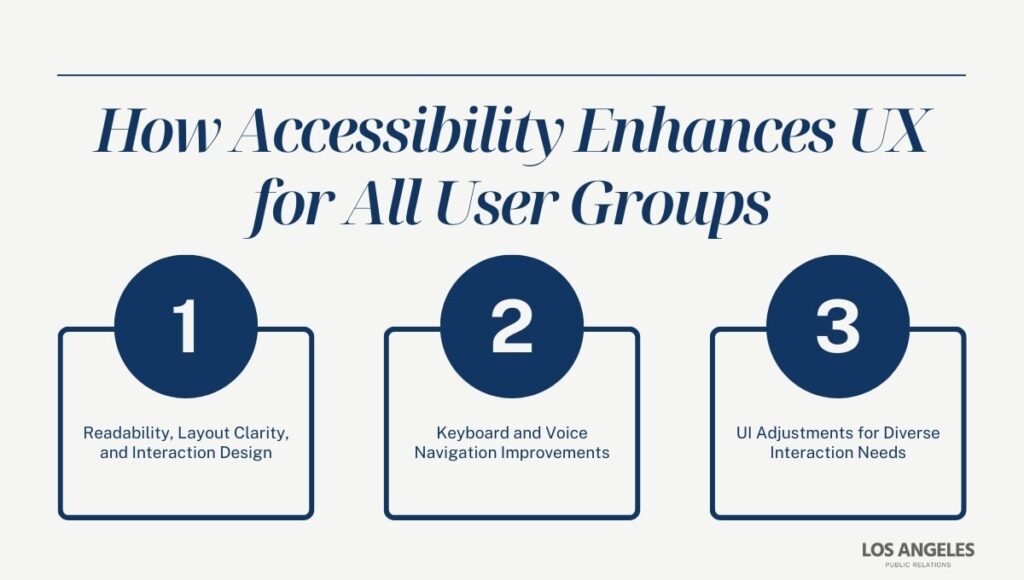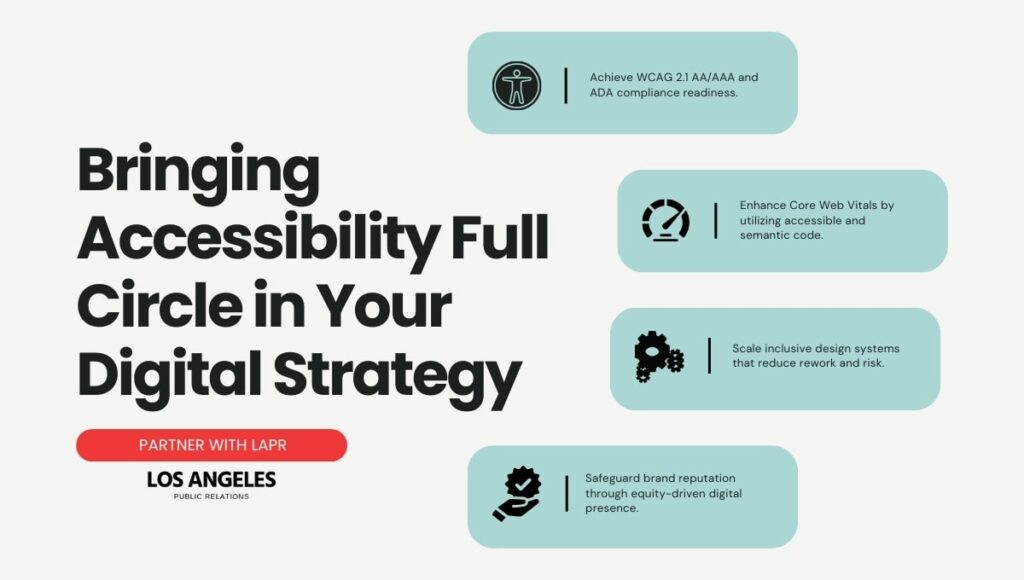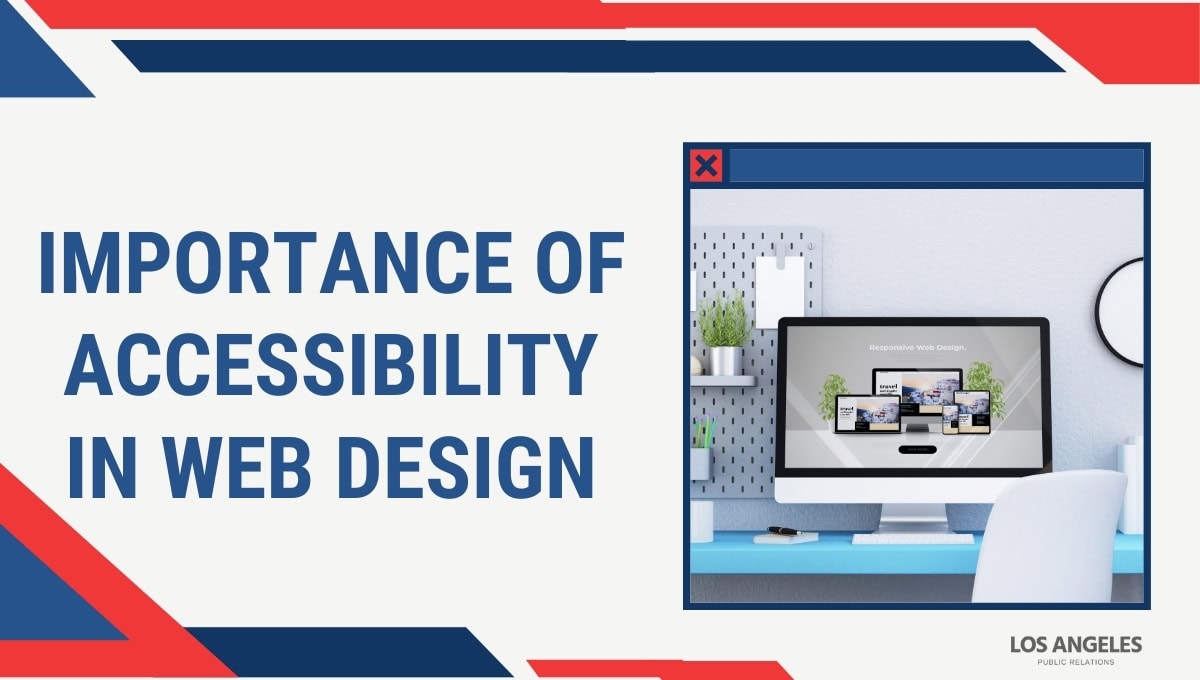Accessibility is now a critical factor in how websites perform, rank, and scale. It directly influences Core Web Vitals, impacts how assistive technologies interpret your content, and plays a central role in meeting legal requirements under the ADA Title III, WCAG 2.1, and Section 508 compliance standards.
Meeting those standards and unlocking the performance gains tied to accessibility starts with your technical foundation. Elements like semantic HTML, ARIA roles, and keyboard navigation must be implemented correctly. Because when these are missing, certain types of users are excluded, SEO signals break down, and legal risk increases. And these failures often begin at the structural level, before even a single page goes live.
At Los Angeles Public Relations (LAPR), we bring over 20 years of expertise in helping teams turn accessibility into a scalable design standard, built from the ground up to improve visibility, retention, and compliance readiness.
That foundation begins with understanding accessibility as a core component of digital infrastructure, which is essential to inclusion, performance, and sustainable growth.
Table of Contents
ToggleWhat Is Accessibility in Web Design and Why Is It Important?
Web accessibility in web design refers to creating websites and digital content that can be easily used by people of all abilities, including those with visual, auditory, motor, or cognitive impairments. It involves designing interfaces that work with assistive technologies (like screen readers), support keyboard navigation, provide clear structure and semantics, and ensure content is perceivable, operable, understandable, and robust for everyone.
In short, accessible web design makes sure no one is excluded from using a website due to a disability or limitation.
Beyond inclusion, accessibility also supports legal compliance with standards like the WCAG and ADA, reduces bounce rates, improves SEO, and enhances overall usability for all users – not just those with disabilities. By designing with accessibility in mind, businesses build more ethical, effective, and future-proof digital experiences.
Core Standards: WCAG, ADA, and Section 508
The foundation of accessible web design is built on enforceable standards that define how digital content must function for all users. The Web Content Accessibility Guidelines (WCAG 2.1), the Americans with Disabilities Act (ADA) Title III, and Section 508 each outline critical requirements for accessible interactions: such as screen reader compatibility, keyboard navigation, form usability, and real-time content updates.
| Standard | Applies To | Mandates | Risk of Non-Compliance |
| WCAG 2.1 | All public-facing websites | POUR principles (Perceivable, Operable, Understandable, Robust) across all devices and inputs | Poor UX, screen reader failures, audit flags |
| ADA Title III | U.S. private businesses | Equal digital access for individuals with disabilities | Legal action, fines, mandatory remediation |
| Section 508 | U.S. federal agencies and contractors | Accessibility in public- and employee-facing systems | Loss of federal contracts, compliance penalties |
These standards exist to protect users from exclusion and to hold organizations accountable for digital equity and public access.
Disabilities Addressed by Accessible Design
Effective accessible design considers four core categories of disability: visual, auditory, motor, and cognitive. Each presents unique user experience (UX) challenges that can be resolved through intentional, inclusive design choices at both the code and content levels.
| Disability | UX Barrier | Impact | Accessibility Solution | Assistive Technology |
| Visual | Missing alt text for images | Lack of content context | Add meaningful alt attributes | Screen readers |
| Auditory | Auto-playing media without captions | Users miss key information | Include accurate, synchronized captions | Captioning tools, transcripts |
| Motor | Small click targets, no keyboard support | Difficulty navigating or interacting | Use larger buttons, enable full keyboard navigation | Switch devices, adaptive hardware |
| Cognitive | Confusing layout, inconsistent structure | User frustration and task abandonment | Simplify navigation, use clear headings and language | Text simplifiers, focus tools |
Accessible design isn’t just about compliance; it enhances usability for everyone. These improvements help users across a wide range of abilities, devices, and environments, creating a more inclusive and effective digital experience.

Why Accessibility Starts with Inclusive Design Thinking
Inclusive design thinking is the foundation of accessible digital experiences. It proactively considers the full range of human diversity: abilities, languages, devices, and contexts, from the very beginning of the design process. By addressing accessibility before any UI components, layouts, or content systems are finalized, teams can reduce costly rework and embed usability into the product’s DNA.
Designing with inclusion in mind supports the core principles defined by accessibility standards like WCAG:
- Perceivable: Content is accessible to users with visual, auditory, or sensory differences
- Operable: Interfaces work with keyboards, adaptive switches, voice input, and more
- Understandable: Navigation and interactions follow predictable, consistent patterns
- Robust: Content is compatible with a wide range of assistive technologies and browsers
When accessibility is integrated as a design input, rather than being treated as an afterthought or a compliance hurdle, it leads to digital products that are more resilient, scalable, and intuitive for all users.
For instance, a university that launched a multilingual portal with scalable typography and simplified navigation saw a 38% reduction in user abandonment, proof that inclusive design delivers measurable, real-world results.
How Accessibility in Web Design Supports SEO and Mobile Optimization
Accessibility influences how your site is indexed, rendered, and interacted with, particularly under Google’s mobile-first indexing model. Core techniques, such as semantic HTML, ARIA roles, and device-consistent layouts, directly impact crawl performance, ranking stability, and usability.
The technical structure behind accessibility isn’t just user-focused. It powers search visibility and ensures that content loads cleanly across various screen sizes and input types.
Semantic HTML and ARIA in SEO Performance
Search engines and assistive technologies rely on structured markup to interpret content. Semantic HTML provides the clarity both need, while ARIA roles enhance context when native elements fall short.
| Technique | SEO Benefit | Accessibility Tie-In |
| <main>, <nav>, <header> | Helps search engines segment content | Allows screen readers to identify page regions |
| aria-label, aria-labelledby | Adds metadata for dynamic elements | Enables assistive tech to interpret the UI purpose |
| Logical DOM order | Improves crawl accuracy | Preserves reading order for screen readers |
Using these correctly ensures that content is both discoverable by bots and usable by real users, without redundancy or confusion.
Mobile Responsiveness Aligned With Accessibility Alignment
Google evaluates mobile usability as a key ranking signal. Accessibility reinforces this by ensuring designs are readable, tappable, and functional across devices, orientations, and contexts.
Core mobile-accessibility techniques include:
- Touch targets ≥ 48px: Reduces error rate and supports motor-impaired users.
- Zoom and font-resize compatibility: Enhances readability for users with low vision.
- Logical reading order: Ensures content is processed in the intended sequence.
- Alt text for icons and buttons: Delivers meaning to screen readers.
- Responsive, fluid layouts: Supports flexible orientation and screen sizes.
These practices improve performance scores, minimize friction for mobile users, and help meet WCAG mobile-specific criteria.
Structured Data, Crawlability, and Search Signals
Accessible websites are easier to index. Clear navigation, logical hierarchy, and structured markup benefit both assistive tools and search engine crawlers. Google prioritizes sites that are readable, usable, and well-labeled.
To illustrate how accessibility supports technical SEO, here are key HTML and UX elements that influence both search visibility and user access:
| Element | Impact | Tool |
| Schema.org markup | Enhances SERP snippets and screen reader interpretation | Rich Results Test |
| Skip links (#maincontent) | Supports keyboard users and quick content access | Manual screen reader test |
| Crawlable navigation | Improves page discovery across the site hierarchy | Lighthouse audit |
| Hidden content without markup | Obstructs both bots and assistive tech | Manual DOM inspection |
When your code is accessible, it becomes more interpretable. That clarity boosts both your rankings and your user retention across devices.
How Accessibility Enhances UX for All User Groups
Accessible design improves usability across all demographics, not just for users with disabilities. When layouts follow consistent patterns, interfaces respond predictably, and input flexibility is respected, engagement and retention rise across the board. Accessibility shapes the very UX patterns that reduce friction, cognitive load, and abandonment.
Readability, Layout Clarity, and Interaction Design
Visual structure drives accessible interaction. Readable text, intuitive hierarchy, and clear spacing support user comprehension and ease of use. These elements also align with industry standards for readability and cognitive processing.
The following layout choices illustrate how small design details can significantly improve accessibility and usability for all users:
| Design Pattern | UX Function | Accessibility Benefit |
| Font size ≥ 16px | Improves readability | Assists users with low vision |
| Line height ≥ 1.5 | Reduces visual strain | Supports users with dyslexia |
| Logical heading hierarchy | Enhances content scanning | Enables structured screen reader output |
| Ample white space | Lowers cognitive overload | Increases clarity for all interaction modes |
When the structure is predictable and readable, users tend to engage for longer periods and navigate with less effort.
Keyboard and Voice Navigation Improvements
Many users rely on keyboard or voice input for navigating the site. Accessibility ensures that tabbing, skipping, and command-based interfaces work reliably. These features reduce friction and make content available without the need for a mouse or touchscreen.
The key navigation patterns that improve interaction for keyboard and voice users, along with the barriers they help avoid, are:
| Navigation Pattern | Barrier Avoided |
| Tab-indexed elements | Prevents keyboard traps |
| Skip links (#maincontent) | Avoids repetitive tabbing |
| Landmark roles | Guides voice-controlled access |
Testing with screen readers and voice tools ensures that non-mouse users get full functionality without delay or confusion.
UI Adjustments for Diverse Interaction Needs
Small UI decisions can drastically impact usability for users with motor, cognitive, or situational challenges. Accessible interfaces account for those variances and maintain functionality in varied real-world contexts.
The following UI patterns illustrate practical ways to improve interaction for users with different needs, ensuring functionality across input methods, devices, and sensory conditions:
| UI Pattern | Issue Solved | Fix Type |
| Avoid hover-only menus | Mouse-only exclusion | Add keyboard triggers |
| Allow pauses on timeouts | Motor/cognitive overload | WCAG 2.2.1 compliance |
| Use redundant cues (icon + text) | Colorblind barriers | Adds multisensory confirmation |
These design principles benefit not only those with impairments. They create a more responsive and usable experience for all device types and environments.

Why Accessibility Compliance Is Critical for Legal and Financial Risk Management
Digital inaccessibility is now a legal liability, not just a technical oversight. Regulatory frameworks, such as the ADA, EAA, and Section 508, enforce accessibility at both national and international levels. Violations trigger lawsuits, fines, contract rejections, and reputational damage. Each enforcement channel operates differently, but the risk is real and accelerating across industries.
Legal Expectations: ADA, EAA, and Section 508
Regulations vary by region and sector, but all mandate barrier-free digital access. These laws apply based on business operations and target audience, making compliance essential for risk mitigation and market eligibility.
The table below outlines how key accessibility laws differ in scope, enforcement, and consequence, critical knowledge for global brands, contractors, and public-facing platforms:
| Law | Applies To | Requirements | Penalties |
| ADA | U.S. private businesses | Equal access to websites and digital services | Civil lawsuits, damages, injunctive relief |
| EAA | EU-based and EU-operating entities | Inclusive digital product standards | Trade restrictions, blocked market entry |
| Section 508 | U.S. federal agencies, vendors | Accessible tech for public use and employees | Procurement disqualification, federal penalties |
Non-compliance can halt operations, restrict funding, or lead to public litigation, all of which elevate accessibility to a core legal priority.
Risk Exposure for Public, Private, and Nonprofit Entities
Legal exposure scales with digital footprint, industry type, and funding source. Organizations that serve the public, whether government, corporate, or nonprofit, face scrutiny at both the compliance and brand-trust levels regarding accessibility.
The table below outlines common risk categories by entity type, showing how accessibility failures can trigger lawsuits, penalties, or lost opportunities:
| Entity Type | Risk Exposure | Example |
| Government/Education | Federal audits, procurement loss | Public universities, K–12 sites |
| Private Sector | ADA lawsuits, consumer abandonment | e-commerce, SaaS, media brands |
| Nonprofit | Grant denial, reputational damage | Health NGOs, advocacy orgs |
The private sector is now experiencing the fastest rise in ADA Title III lawsuits, particularly among retail, food service, and technology platforms.
Notable Lawsuits and Industry Precedents
Real-world litigation reinforces that digital inaccessibility carries enforceable consequences. These landmark cases established clear expectations around web compatibility and inclusive access:
- Harvard/MIT (2020): No captions on video content → $1.5M settlement → Defined educational media requirements.
- Domino’s Pizza (2019): App lacked screen reader support → Case upheld → Confirmed ADA applies to digital tools.
- Beyoncé.com (2019): Visual-only design excluded screen reader users → Class-action lawsuit → Sparked entertainment sector reviews.
- Winn-Dixie (2017): No keyboard support → Plaintiff won → First retail ADA web accessibility precedent.
- Netflix (2012): Lack of closed captions → Legal action and accessibility agreement → Extended ADA scope to online-only services.
These decisions clarified that digital platforms, regardless of business model, must meet accessibility standards or face litigation.
Why Accessibility Is a Moral, Inclusive, and Human-Centered Obligation
Digital access is a human right. When digital environments exclude people with disabilities, the result is systemic discrimination, undermining inclusion, equity, and trust. Inaccessibility reflects a brand’s failure to align with DEI, ESG, and ethical design principles. Making accessibility foundational is no longer optional; it defines responsible digital citizenship.
Real-World Impact on Users with Disabilities
Design oversights don’t just create friction; they block access. Poor accessibility causes real harm: missed opportunities, abandoned tasks, and exclusion from critical services. These are part of your core audience.
| User Type | Barrier | Impact | Fix | Tool |
| Screen reader user | Unlabeled buttons | Navigation failure, missed actions | Add aria-label, aria-labelledby | NVDA, VoiceOver |
| Older adult | Small fonts, low contrast | Visual fatigue, dropped sessions | Use scalable fonts, 4.5:1 contrast ratios | Lighthouse audit |
| Neurodivergent user | Flashing UI, erratic motion | Sensory overload, confusion | Use prefers-reduced-motion, logical hierarchy | Motion simulator |
Accessible UX preserves dignity and ensures that people with disabilities are not excluded from everyday interactions.
Digital Inclusion Across Economic and Demographic Divides
Inclusive design also protects against indirect exclusion caused by factors such as age, language, technical limitations, or temporary impairments. Accessibility scaled across these variables increases retention, improves mobile engagement, and builds resilient digital experiences.
The following examples highlight common points of friction experienced by diverse user groups and the design adaptations that help eliminate them:
| Audience | Friction | Fix |
| Multilingual users | Hardcoded UI text | Use lang attributes |
| Older adults | Low color contrast | Apply WCAG AA contrast ratios |
| Mobile-first users | Small touch targets | Use 48px+ buttons and large hit areas |
| Temporarily impaired | Mouse-only interfaces | Support full keyboard navigation |
Designing for diversity delivers operational scale while driving long-term engagement.
Social Responsibility and Public Trust
Accessibility reflects your brand’s values in action. It signals digital ethics, DEI alignment, and a commitment to equity. As user expectations shift toward inclusive design, so do the priorities of investors and partners.
For key stakeholders, accessibility now plays a direct role in perception, loyalty, and eligibility:
- Users expect frictionless access; accessibility builds loyalty and inclusion.
- Investors demand ESG adherence; accessibility lowers reputational risk.
- Partners require compliance signals; accessibility increases credibility and procurement eligibility.
Accessible design builds social capital and positions your brand as accountable, future-ready, and trusted.
Who Needs to Prioritize Accessibility in Web Projects in 2025?
In 2025, accessibility is a shared responsibility across teams. Legal enforcement, procurement filters, and user demands require that everyone, from designers to executives, treat accessibility as a baseline standard. If you create, manage, or approve digital products, accessibility is part of your role.
Roles Most Responsible for Digital Accessibility
Accountability spans multiple disciplines. These roles each shape accessibility outcomes from different angles:
| Role | Responsibility | Outcome |
| UX Designer | Defines interaction patterns, visual hierarchy | Enables perceivable, operable UI |
| Frontend Developer | Applies semantic HTML, ARIA attributes | Structures content for screen readers, input consistency |
| QA Tester | Runs keyboard tests, assistive tech validation | Prevents navigation traps, confirms accessibility functions |
| Compliance Officer | Audits WCAG alignment, monitors evolving laws | Reduces legal exposure, ensures policy adherence |
| Content Strategist | Crafts clear headings, alt text, descriptive copy | Improves readability, enables screen reader comprehension |
Digital accessibility success depends on each of these disciplines treating it as part of core execution, not peripheral compliance.
High-Risk Sectors and Under-Regulated Industries
Some industries face higher legal and operational exposure due to the critical nature of their services or the evolving nature of compliance enforcement.
| Sector | Legal Exposure | Risk Factor |
| E-commerce | ADA | High volume of user claims |
| Healthcare | Section 504/508 | Critical service dependencies |
| Banking | ADA + Financial regs | Transactional access requirements |
| Education | Section 508 + EAA | Statutory accessibility mandates |
In high-risk sectors, inaccessible interfaces are not just UX issues, but also legal and operational vulnerabilities.
Market Trends Accelerating Accessibility Mandates
Three accelerating trends are pushing organizations to integrate accessibility across the entire product lifecycle:
- ADA litigation is up 12% year-over-year: Accessibility failures now lead to rapid lawsuits, settlements, and reputational damage, making legal compliance a board-level concern.
- Enterprise DEI policies now operationalize accessibility: Diversity, Equity, and Inclusion (DEI) initiatives are embedding accessibility into design systems, requiring teams to deliver inclusive experiences by default.
- AI-powered accessibility audits are built into RFP requirements: Buyers now demand automated compliance scans as part of vendor evaluation. Failing these checks can disqualify bids and block contracts.
These shifts make one thing clear: accessibility is no longer a post-launch checklist item: it’s a non-negotiable prerequisite for procurement, compliance, and long-term product trust.
How to Identify and Fix Website Accessibility Gaps
Most accessibility issues are hidden in markup, structure, or interactive flows. Solving them requires a continuous audit strategy that combines automated scans, manual reviews, and input from real users. Accessible websites are not built through one-time fixes, but through monitored, testable systems.
Accessibility Audit Tools: Axe, WAVE, Lighthouse
Automated tools detect code-level issues quickly, but they don’t cover all accessibility dimensions. Each serves a distinct role in a comprehensive audit pipeline:
| Tool | Best Use Case | Strength |
| Axe | Developer-first audits, CI/CD integration | Flags contrast, ARIA, landmark gaps |
| WAVE | Visual inspection by content or design teams | Highlights headings, structure, form labels |
| Lighthouse | SEO-aligned accessibility scoring | Evaluates Core Web Vitals + accessibility performance |
Combine automated scans with manual validation to catch behavioral, navigational, and perception issues missed by bots.
Common Accessibility Issues and How to Fix Them
Frequent accessibility gaps directly impact user tasks and legal exposure. Most are preventable with basic implementation hygiene:
| Issue | UX Problem | Fix | WCAG Ref |
| Missing alt text | Images lack screen reader context | Add accurate alt attributes | 1.1.1 |
| Low contrast | Text unreadable for low-vision users | Increase text/background contrast | 1.4.3 |
| Unlabeled inputs | Forms unclear to assistive tech | Add <label> or aria-label | 3.3.2 |
| Keyboard traps | Users can’t exit interactive areas | Ensure focus can move or exit | 2.1.2 |
Addressing these issues improves both user experience and audit readiness, without requiring full design overhauls.
Device Consistency and Cross-Platform Usability
Cross-platform accessibility ensures consistent interaction quality across devices, operating systems, and assistive technologies. Reliable testing spans three dimensions:
- Assistive Tech Compatibility
- Test with NVDA, VoiceOver, and JAWS
- Validate ARIA role interpretation and region announcements
- Responsive Behavior
- Check scaling with browser zoom and screen resizing
- Ensure reflow and readability meet WCAG 1.4.10
- Focus Management
- Test sequential tab order
- Highlight visible focus states
- Prevent loss of focus on modal or dynamic components
Without consistency across devices and tools, compliant code won’t translate into real-world usability.
Monitoring Accessibility Through Feedback Systems and Public Statements
Sustainable accessibility depends on clear accountability and active feedback mechanisms. Long-term compliance and usability require built-in monitoring.
Include these governance actions:
- Add in-page reporting tools to collect real-time accessibility feedback
- Publish an Accessibility Statement that outlines WCAG level targets and contact info
- Schedule recurring audits (quarterly or bi-annually) to detect regressions
- Use tools like Axe Monitor or Siteimprove for automated tracking
Monitoring reinforces credibility, ensures iterative improvement, and signals a proactive commitment to inclusion.
How Teams Can Operationalize Accessibility From the Start
Accessibility is most effective when integrated at the earliest stages of product development. Embedding accessibility during planning and design reduces future risk, supports faster delivery, and ensures inclusive systems scale consistently across platforms and teams.
Semantic-First Development and Native Accessibility
Native HTML and ARIA offer foundational accessibility when used correctly. Applying them early ensures structure, meaning, and usability are preserved across devices and assistive technologies.
| Technique | Benefit | WCAG Reference |
| Semantic HTML | Logical flow for users and bots | 1.3.1 |
| ARIA roles | Adds clarity where native HTML falls short | 4.1.2 |
| Keyboard navigation | Maintains navigability and focus control | 2.1.1 |
These elements should be built into design tokens and UI specs, not applied retroactively.
Retrofitting vs. Inclusive Design From the Outset
Planning for accessibility after launch multiplies risk and rework. Design-stage integration is faster, cheaper, and safer.
| Phase | Cost to Add Accessibility | Risk Level |
| Design | Low | Preventative |
| Development | Medium | Manageable |
| Post-Launch | High | Legal Exposure |
Building access into wireframes avoids late-stage code debt and missed compliance timelines.
Scalable Accessibility With Pattern Libraries and Agile Workflows
Scalable accessibility depends on reusable, tested design systems. Pattern libraries maintain consistency, reduce regressions, and embed compliance into daily dev cycles.
- Use accessible libraries like Material, USWDS, or Lightning
- Enforce ARIA and keyboard support in reusable components
- Integrate checks into sprints to prevent backlog growth
Component-driven accessibility ensures consistency, even across fast-moving Agile teams.

How Los Angeles Public Relations Enables Full Accessibility Compliance
LAPR enables brands to meet full WCAG 2.1 AA/AAA standards through structured remediation, technical execution, and brand-aligned communication. Our accessibility solutions combine audit precision with legal alignment and UX performance.
End-to-End Framework: Audit to Implementation
LAPR applies a four-phase framework to identify, fix, and monitor accessibility issues:
- Audit: Axe, WAVE, and manual screen reader checks to map WCAG violations
- Prioritization: Rank issues by user impact and legal risk
- Remediation: Developer-ready fixes tied to WCAG success criteria
- Monitoring: Quarterly checks, KPIs, and stakeholder reporting
Each stage ensures traceable compliance and scalable integration.
Team Expertise: UX, Compliance, Development, PR
Our cross-disciplinary team at Los Angeles Public Relations (LAPR) spans:
- UX: Builds inclusive patterns and accessible flows
- Compliance: Aligns output with ADA, Section 508, and WCAG
- Development: Implements semantic structure and ARIA roles
- PR: Crafts DEI-forward accessibility narratives
This alignment reduces rework and enhances stakeholder confidence.
WCAG Alignment and ADA Communication Readiness
We combine technical accuracy with a communication strategy:
- Accessibility statements for public posting and RFPs
- VPATs for federal and enterprise procurement
- Language audits for inclusive, compliant messaging
LAPR helps organizations meet both legal mandates and user expectations.
What Accessibility Means for Your Internal Teams
Sustainable accessibility starts with internal ownership. It’s not maintained solely through audits, but through cross-functional habits embedded in day-to-day workflows. When UX, engineering, legal, and content teams internalize accessibility standards, compliance becomes consistent, and culture becomes inclusive by design.
Collaborative Models for UX, Dev, Content, Legal, and Comms
Effective implementation requires each team to own accessibility within their scope. Clear coordination ensures that no accessibility task is missed in production or communication.
| Function | Accessibility Contribution |
| UX | Validates pattern usability and interaction equity |
| Development | Delivers semantic markup, ARIA roles, focus logic |
| Content | Maintains clarity, alternative text, and reading order |
| Legal | Reviews policies for WCAG/ADA alignment |
| Communications | Ensures messaging is inclusive and brand-consistent |
Internal Communication and Accessibility Culture
Embedding accessibility in internal communication reinforces awareness and adoption. Team rituals, onboarding, and editorial tone should reflect inclusive practices.
- Onboarding guides include accessibility expectations by role
- Content libraries promote consistent, inclusive language
- Slack channels or intranets allow for accessibility queries and learning
Building Long-Term Capability Through Training
Ongoing education strengthens team fluency in inclusive design and execution. Training should be scoped by discipline and refreshed routinely.
- Role-specific sessions on topics like screen reader testing, alt text writing, and contrast validation
- Governance playbooks outlining accountability and process checkpoints
- Accessibility champions within teams to lead peer support and awareness
Usability vs. Accessibility vs. Inclusive Design: What’s the Difference?
Clarity between usability, accessibility, and inclusive design prevents misalignment. Each serves a distinct function, efficiency, equity, and universality, yet they intersect in shaping resilient, user-centered interfaces.
| Concept | Definition | Primary Goal |
| Usability | Efficient for most users | Productivity |
| Accessibility | Functional for all users | Equity |
| Inclusive Design | Designed for user variance | Universality |
Functional Usability Versus Access Design
A usable interface isn’t always accessible. UI shortcuts like hover menus or modal dialogs, boost speed but may block assistive navigation. Balancing both ensures neither efficiency nor equity is compromised.
| UX Pattern | Usability Role | Accessibility Fix |
| Hover menus | Faster access | Add keyboard support |
| Modals | Task focus | Ensure focus management |
Inclusive Design for Diverse Human Needs
Inclusive design anticipates differences rather than reacting to them. It broadens UX beyond the ability to cover age, context, and cultural variance.
Examples of inclusive approaches:
- Adjustable content density for cognitive support
- Flexible input modes for different tech access
- Visual and textual redundancy for perception clarity
Mobile-First Thinking as a Foundation for Inclusion
Mobile-first design naturally aligns with inclusive goals. It accounts for limited space, varied input methods, and constrained networks, conditions that mirror accessibility edge cases.
| Pattern | Inclusive Benefit |
| Large touch targets | Supports motor precision |
| Prioritized content | Reduces overload, aids scanning |
| Lightweight assets | Improves access on a limited bandwidth |
Designing with mobile-first constraints inherently builds broader accessibility and performance resilience.
Bringing Accessibility Full Circle in Your Digital Strategy
Accessibility reflects your brand’s integrity, strategic foresight, and user commitment. At Los Angeles Public Relations (LAPR), we integrate accessibility into the core of digital ecosystems, aligning legal standards with UX excellence and SEO performance.
Partner with LAPR to:
- Achieve WCAG 2.1 AA/AAA and ADA compliance readiness.
- Enhance Core Web Vitals by utilizing accessible and semantic code.
- Scale inclusive design systems that reduce rework and risk.
- Safeguard brand reputation through equity-driven digital presence.
Accessibility isn’t an add-on. It’s a competitive differentiator. Secure compliance, protect your brand, and reach more users by embedding accessibility at every level.

| Start Your Accessibility Journey With Los Angeles Public Relations. Schedule your consultation now! |





